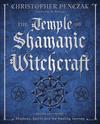What Is a Shamanic Witch?

Alongside writing and teaching witchcraft, I also teach classes on holistic health and alternative healing methods at local centers in the New England area. Most of my students don’t know my background as a Wiccan author, and just assume that I have a more traditional background. I've found that the practices of magickal healing and alternative healing are not always far apart.
In a class on the techniques of shamanic healing, I had a very interesting conversation. One participant talked about how spiritually difficult it was to come from European descent, since we only have traditions based upon the Bible. He was upset that, unlike the Native Americans and other tribal people, we didn't have our own traditions of shamanism and spirit medicine. He understood that if we want a shamanic experience, we have to explore other cultures and traditions.
Though I could sympathize, I had to correct him. Europeans do have their own brand of shamanism. It evolved into what we now think of as witchcraft. As a culture, we feared, persecuted, and destroyed our shamanic heritage. We had it all along, and we still do, but most fail to recognize it. It has survived in the strains of folk magick and faery faith practices. It has been revived as one of the strands in the web of contemporary witchcraft.
Shamanism technically refers to the medicine practices of the tribes in Siberia, and has been used in reference to the medicine people of Asia and the Americas. The term shaman has become a catch phrase for some basic techniques and concepts found worldwide, regardless of the tribe, culture, or religion that surrounds it. This perpetuates the idea of tools for "core shamanism" that can be used by anyone, because they appear to be universal. Techniques of core shamanism include:
- Using trance techniques such as drumming, dancing, and plant substances to induce an altered state of consciousness.
- While in an altered state of consciousness, projecting your awareness to a non-physical world, often by climbing some form of cosmic axis. Many cultures describe the axis as a world tree, reaching into three worlds: the heavens, the world of human life, and the underworld.
- Contact with non-physical spirits who can grant advice or healing power.
- Working with the spirits of animals and plants, both in the physical and non-physical worlds.
Core shamanism has led to the concepts of Celtic shamanism, Norse shamanism, and even Wiccan shamanism. An old Celtic druid or seer who practices these techniques never referred to himself as a shaman, just as a Siberian shaman would never call himself a Siberian druid. But many of the basic concepts are the same, particularly in regard to other worlds, spirit working, and journeying. Shaman has become a modern default term.
In modern witchcraft, many focus solely on the craft of the witch, through spells, rituals, and holiday celebrations. While this is a wonderful place to start, and many traditions focus exclusively on these tools, the mysteries of witchcraft are very shamanic. Those who explore witchcraft further learn to work deeply with the spirits, and to work on healing all levels of their being. The old hedge witch knew spellcraft, herbalism, and how to work with the spirits. Witches are known to communicate with animal familiars, the deceased, faeries, angels, and gods. One of the first definitions of a witch that I learned from my teachers is a "a walker between the worlds." That phrase is also used to describe shamans. We stand with one foot in the physical and one foot in the spiritual, both firmly rooted. We act as the gate between worlds—a crossroads to aid others on both sides. We form partnerships between the human and spirit worlds for the good of all.
The Temple of Shamanic Witchcraft draws together many practices, from traditional witchcraft to modern forms of shamanism. Though there are a lot of good witchcraft books and a lot of good shamanism books available, few tackle the two topics together in a practical, hands-on manner. I wanted to create the book that reflected what I practice and what I teach, finding the common ground of both, and looking to the future.
One practice that is talked about in many spiritual traditions is the concept of knowing your "shadow." It is the repressed part of your self that is often the root of our self-sabotaging behavior. Our fears, angers, and hurts give it a lot of power, and as long as we deny it, we lose that power. By partnering with it, the shadow becomes an ally, but you must know your shadow, and heal the rift between you both.
The Temple of Shamanic Witchcraft is a year-long course, much like its predecessors, The Inner Temple of Witchcraft and The Outer Temple of Witchcraft, guiding you in the healing craft with profound exercises and rituals to "distill your shadow" into knowable form. Through this knowledge, you are transformed and reborn. The companion CDs contain drumming, rattling, and singing bowls to aid your journeys, as well as guided meditations of many of the exercises. They make the format close to taking a class, with a teacher guiding the way.
If you've never thought about how the role of the witch and the shaman intersect, or if you've never had a guide to aid you in the exploration, I encourage you to explore The Temple of Shamanic Witchcraft.

About Christopher Penczak
Related Products

is subject to certain Terms and Conditions